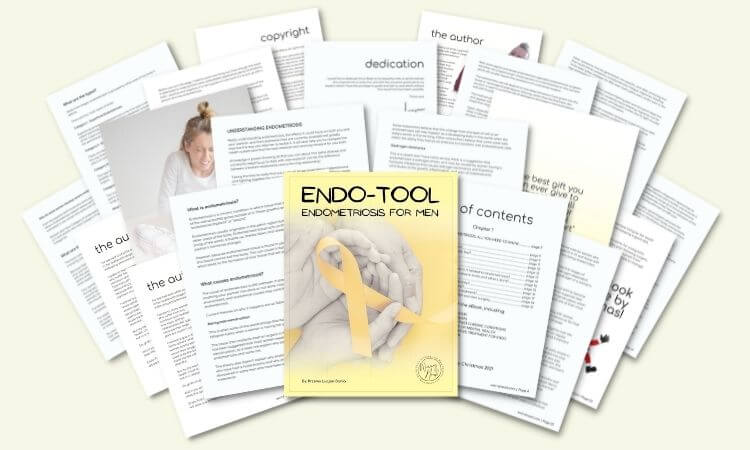What are the signs your partner has endometriosis?
Endometriosis is a condition in which endometrium-like tissue, or tissue similar to the lining of your partner’s uterus, grows outside of her uterus. This can cause pain, heavy bleeding, and many other problems. So then what are the signs your partner has endometriosis?
It can be difficult to give you a quick reference to the signs of endometriosis because it is a complex chronic condition, but below you will find a quick answer to the question…
What are the signs your partner has endometriosis?
The undisputed signs of endometriosis are pelvic pain and infertility. Other signs your partner has endometriosis may include pain during or after intercourse, heavy bleeding or spotting between periods, chronic fatigue, gastrointestinal issues like bloating, constipation, diarrhea, painful urination, or bowel movements.
Endometriosis can be a difficult condition to diagnose because the signs and symptoms vary so much from person to person, but if your partner is experiencing any of these signs, she should see a doctor, and insist to get checked out.
You need to accompany your partner to her doctor’s appointment because many doctors aren’t aware of the symptoms of endometriosis and are likely to gaslight your partner by saying things like “it’s all in her head” or “it’s just a bad period.”
In order to prevent that from happening, your presence as a man by her side will be extremely beneficial. It is important because early diagnosis and treatment are important to managing the condition and preventing further complications.
If you want to learn more about endometriosis, I wrote an “Endo-Tool, Endometriosis for Men” e-Book of which you can get a FREE 1st chapter containing all you need to know about this chronic condition, plus how to cope and support your partner.
- What is endometriosis?
- What are the symptoms?
- What causes endometriosis?
- What does endometriosis look like?
- What are the stages?
- What are the types?
- What is adenomyosis and how is it related to endometriosis?
- Why do some women develop severe endo and others don’t?
- Does endometriosis cause infertility?
- How is endometriosis diagnosed?
- Do types and stages affect the treatment?
- Recurrence of endometriosis after excision surgery.
FREE Chapter of “Endo-Tool”!
an Endometriosis for Men book

How can you tell if your partner has endometriosis?
Unfortunately, your partner is likely to go through the process of the medical system, meaning, her precious time, and patience will be put up for a test.
Firstly, the doctor is going to ask about her symptoms, and take her history. If you are lucky, you will meet a doctor who has some knowledge about this condition and is going to ask questions to confirm any signs of endometriosis.
Ideally, it should be a BSGE endometriosis specialist, otherwise, prepare yourselves for a ride of arguments with a doctor who never heard before about endometriosis. It can make you both feel very frustrated, but unfortunately, the medical system is lagging behind in this aspect.
Endometriosis diagnosis.
After the initial consultation, if the doctor suspects that your partner has endometriosis, then she will most likely be referred for a pelvic ultrasound. This is a painless scan that uses sound waves to create an image of the inside of her pelvis.
The scan can often confirm the presence of endometriosis, but it isn’t always possible to say how severe it is.
Next, an MRI scan might be recommended. This is a more detailed scan that can give a better idea of how much endometriosis is present and where it is. However, the guarantee of noticing endometriosis via MRI is only 50%.
If the MRI doesn’t confirm endometriosis, or if there is still some doubt about the diagnosis, a laparoscopy might be recommended.
Laparoscopy should be recommended, as it is the only definite way to diagnose endometriosis!
A laparoscopy is a surgical procedure in which a thin telescope-like instrument is inserted into the pelvis through a small cut in the tummy. This allows the surgeon to have a direct look at the pelvic organs and check for endometriosis.
If endometriosis is found, the surgeon can then treat it during the same procedure.
Treatment of endometriosis.
Endometriosis is a complex condition, and unfortunately, there is no cure. However, with the right treatment, the symptoms can be managed, and fertility can often be preserved.
The treatments available will depend on the severity of your partner’s symptoms and whether she wants to conceive in the future.
Medical treatment options include:
- painkillers
- hormonal treatments
- surgery
Painkillers such as paracetamol or ibuprofen can be helpful in managing the pain associated with endometriosis.
Hormonal treatments can help to relieve pain and shrink the size of endometrial growths. These include the combined oral contraceptive pill, progesterone-only pills, gonadotrophin-releasing hormone (GnRH) analogs, and the intrauterine contraceptive device (IUD).
Surgery is often recommended for severe cases of endometriosis. The type of surgery will depend on the severity of the condition and where the endometriosis is located.
Endometriosis can be a very debilitating condition, but with the right treatment, many women are able to live relatively normal lives.
If you suspect that your partner has endometriosis, the best thing you can do is to offer your support and encouragement. Help her to find a good doctor who is willing to listen to her and offer the best possible treatment.

So how can you tell if your partner has endometriosis?
The easiest way to do that, and prove to the doctor that your partner’s symptoms are real is to document them. You can do it by writing things down.
What you should be looking for?
One way is to pay attention to your partner’s menstrual cycle. Being a woman, she most likely does notes for a while already. If she has very heavy periods or periods that last for more than a week, this could be a sign of endometriosis.
Other signs include pain during intimate moments, pelvic pain, and fatigue. If your partner is experiencing any of these symptoms, it’s important to see a doctor so they can get a diagnosis and treatment, but before you both do that, collect at least 3 months’ worth of data.
If you’re not sure whether your partner has endometriosis, the best thing to do is to talk to a doctor online, but it has to be a doctor who specializes in endometriosis. They can help you figure out what’s going on and get the treatment that your partner needs.
But going back to collecting evidence for the doctor (and oftentimes your partner’s boss who might need such confirmation of her telling the truth), the most useful tools to speed up the process of collecting such data are printables, including:
- an intimate moment pain tracker
- a fatigue and energy levels chart
- a monthly period tracker
- a pain diary
- a pain map
How do distinguish regular periods from endometriosis?
There are a few key things to look for when trying to distinguish regular periods from endometriosis.
First, endometriosis is often associated with much heavier periods than what is considered normal. So, if your partner is soaking through a pad or tampon every hour, this is definitely something to note.
Second, endometriosis can cause periods to last much longer than the average of five days. If your partner’s periods are lasting for a week or more, this is another sign that something may be wrong.
Finally, endometriosis is often accompanied by pain. This can include pelvic pain, pain during sex, and pain during or after urination or bowel movements. If your partner is experiencing any of these kinds of pain, it’s important to have her see a doctor.
Summarizing the signs of endometriosis.
In conclusion, endometriosis is a condition that can have a major impact on your partner’s life. If you suspect that she may have endometriosis, the best thing you can do is to offer your support and encouragement. Help her to find a good doctor who is willing to listen to her and offer the best possible treatment.
FREE Chapter of “Endo-Tool”!
an Endometriosis for Men book



About Me
Hi, I’m Lucjan! The reason why I decided to create this blog was my beautiful wife, who experienced a lot of pain in life, but also the lack of information about endometriosis and fibromyalgia for men…
